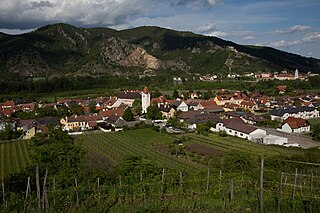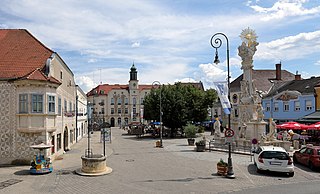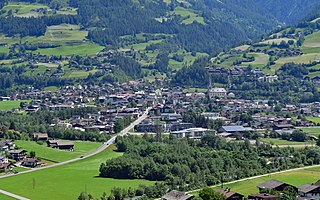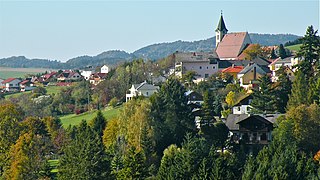
Leobersdorf is a town in the Baden district of Lower Austria, Austria.

Völkermarkt is a town of about 11,000 inhabitants in the Austrian state of Carinthia, the administrative capital of Völkermarkt District. It is located within the Drava valley east of the Carinthian capital Klagenfurt, north of the Karawanken mountain range.

Zwettl is a town and district capital of the Austrian state of Lower Austria. It is chiefly known as the location of Zwettl Abbey, first mentioned in October 1139.

Schladming is a small former mining town in the northwest of the Austrian state of Styria that is now a popular tourist destination. It has become a large winter-sports resort and has held various skiing competitions, including most notably the FIS Alpine World Ski Championships 1982 and the FIS Alpine World Ski Championships 2013. The shopping area has many cafes and restaurants, and a variety of shops that cater to tourists.

Parndorf is a town in the district of Neusiedl am See in the Austrian state of Burgenland. Its original ancient name Perun is derived from the Slavic deity Perun.

Dellach is a municipality in the district of Hermagor, in the Austrian state of Carinthia.

Moosburg is a market town in the Klagenfurt-Land district in the Austrian state of Carinthia.

Althofen is a town in the district of Sankt Veit an der Glan in the Austrian state of Carinthia.

Lendorf is a municipality in the district of Spittal an der Drau in the Austrian state of Carinthia.

Obervellach is a market town in the district of Spittal an der Drau, in the Austrian state of Carinthia.

Hohenthurn is a municipality in the district of Villach-Land in the Austrian state of Carinthia.

Griffen is a market town in the district of Völkermarkt in the Austrian state of Carinthia.

Rossatz-Arnsdorf is a town in the district of Krems-Land in the Austrian state of Lower Austria. It is located in the Wachau valley of the Danube, a popular destination for tourists, and has excellent views of the ruins of castle Dürnstein, where King Richard the Lion-Heart of England was held captive by Duke Leopold V.

Neunkirchen is the capital of the district of Neunkirchen in the Austrian state of Lower Austria. As of 2020 it has a population of 12,721.

Matrei in Osttirol is a market town in the Lienz District in the Austrian state of Tyrol. It is situated about 29 km (18 mi) north of Lienz within the Hohe Tauern mountain range of the Central Eastern Alps. Its municipal area comprises parts of the Granatspitze Group and the Venediger Group, with the Großvenediger peak as its highest point. The population largely depends on tourism, seasonal agriculture and forestry.

Rottenmann is a town in Styria in Austria, near the Rottenmanner Tauern. Rottenmann was first referred to in a document in 927. It received its town charter in 1279 from King Rudolf von Habsburg.

Bad Kreuzen is a municipality in the district Perg in the Austrian state of Upper Austria.

Lannach is a municipality in the district of Deutschlandsberg in the Austrian state of Styria.

Allerheiligen bei Wildon is a municipality in the district of Leibnitz in Styria, Austria. The name "Allerheiligen" translates to "All Saints" and derives from the local church. The addition "bei Wildon" means "near Wildon", thus differentiating the municipality from others of the same name.

Gamlitz is a municipality in the district of Leibnitz in Styria, Austria. In the first known document that mentions it, the settlement is called Gomilnitz, a reference either to the Slavic gomilca which denotes a small hill, or to gom ; indeed Gamlitz is situated among and between rolling hills. The tradition of the local castle goes back to the year 1111.


















